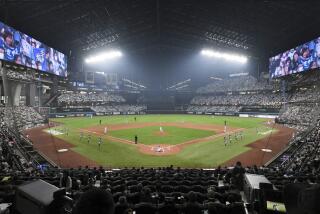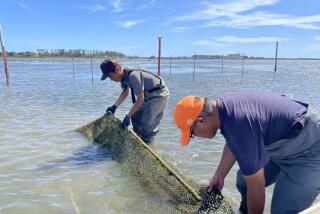Okinawa Seeks to Strike Balance Between Economy and Concern for Environment
- Share via
NAHA, Okinawa — In the farthest southern reaches of Japan, gleaming white beaches slope gently to a clear green sea.
Long-legged herons stand sentry over tidal pools, rare wild cats stalk through semi-tropical forests and the sun shines most days of the year.
But a storm threatens this peaceful vista as the 500 islands that make up the prefecture of Okinawa try to pursue economic development through tourism with plans that critics say could harm the very beauty they seek to promote.
Okinawa lagged far behind while the rest of Japan turned itself into an economic powerhouse. One of the poorest of Japan’s 47 prefectures, wages in Okinawa are about three-quarters of Japan’s average, and its 5% unemployment is double the national figure.
With changes in national development priorities, the Japanese are being encouraged to take more time off work and spend more on leisure.
“We say, why go to Europe, you may as well come to Okinawa where there’s no problem with language, the weather is good and it’s very safe,” said Morimichi Teruya, managing director of the Naha Chamber of Commerce. “We want to beat Hawaii.”
Airport Controversy
One of four new airports planned to cater to the anticipated increase in tourists has, however, drawn strong opposition from local and international conservation groups.
Supporters say the new airport, near Shiraho village on southeastern Ishigaki island, is needed to stimulate the economy. Economic growth, they say, is essential to keep the island alive.
Opponents argue that the runway, which would be built out into the sea off Shiraho, will destroy a large blue coral reef that environmentalists say is the biggest in Japan and perhaps in the world.
“There’s no way you can carry on a development of that dimension and still safeguard the coral reef ecosystem right next to it,” said Tom Milliken, a World Wildlife Fund official in Japan. “It will go environmentally. It will represent a great loss.”
The area is the only part of Japan singled out by the World Wildlife Fund and other international environmental agencies as a priority in a study of development and conservation.
Some supporters of the airport also worry about the environmental effect.
“We depend on the tourist business, so if you see it from that standpoint, we support building the airport,” said Eichi Ono, sales manager of a resort on Kohama island, a 30-minute boat ride from Ishigaki.
“But if it hurts the environment too hard it will hurt those of us who try to promote this place based on its natural environment,” he said.
Low-Key Development
Okinawa contrasts markedly with the urban centers of Tokyo and Osaka, where national development is planned in high-technology offices in high-rise buildings.
In Okinawa’s largest city, Naha, few tall structures loom above the skyline. Wide roads are lined with single-story concrete buildings, softened by pink bougainvillea and other tropical trees and flowers.
The expensive boutiques that flourish in even the small cities of Japan’s four main islands have not yet reached Okinawa, and in the countryside few large factories mar the view.
Okinawa was spared during the 1970s when expanding industry dotted mainland Japan’s rural areas with production plants, largely because of the cost of setting up so far from the main office and the final market.
While the islands have been saved from the scars of development, the lack of opportunity has sent young Okinawans to the prefecture’s larger cities looking for work.
More to Read
Sign up for Essential California
The most important California stories and recommendations in your inbox every morning.
You may occasionally receive promotional content from the Los Angeles Times.













